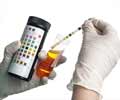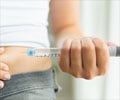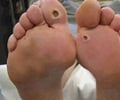Highly-sensitive wearable biosensor using nano-ribbons that can monitor glucose level from body fluid such as sweat and tears has been developed by recent research.
- A highly sensitive device that can monitor glucose level in real-time has been developed.
- This device is a wearable biosenser using nanoribbons.
- It monitors glucose level from the body fluid such as sweat and tears.
An ultra-thin, flexible sensor that could be incorporated into contact lenses or on the back of watches for real-time glucose tracking has been developed by a research team. The team created a biosensor using nanoribbons of indium oxide, an enzyme glucose oxidase, a natural chitosan film and single-walled carbon nanotubes. When glucose is present in a test sample, it interacts with the enzyme, setting off a short chain of reactions and ultimately creating an electrical signal.
Testing showed that the device could detect a range of glucose concentrations from 10 nanomolar to 1 millimolar, which is sensitive enough to cover typical glucose levels in sweat, saliva and tears in people with and without diabetes. Bending the film 100 times didn’t noticeably affect its performance. In addition to glucose tracking, the researchers suggest that the sensor could also be used for monitoring in the food and environmental sectors.
Wearable sensors and devices - development in health care
Wearable sensors are part of an increasingly digitized world. But those that are commercially available typically monitor physical activities by measuring steps taken, for example, or heart rate.
Creating ways to measure health markers on a molecular level has been far more challenging, but the benefits could be life-changing for some. Diagnosing and tracking conditions are often done by analyzing a sample of someone’s blood.
The pain of pricking fingers or drawing blood, however, can deter people from vigilantly monitoring conditions such as diabetes that require regular checks. To take the sting out of the process, wearable glucose sensors are in development but have been hampered by several factors. Some devices can’t detect the low levels of glucose that are in sweat and tears, or they stop working when they’re bent. Moh Amer, Chongwu Zhou and colleagues wanted to tackle these issues.
References:
- Qingzhou Liu, Yihang Liu et al. Highly Sensitive and Wearable In2O3 Nanoribbon Transistor Biosensors with Integrated On-Chip Gate for Glucose Monitoring in Body Fluids, ACS Nano DOI: 10.1021/acsnano.7b06823















